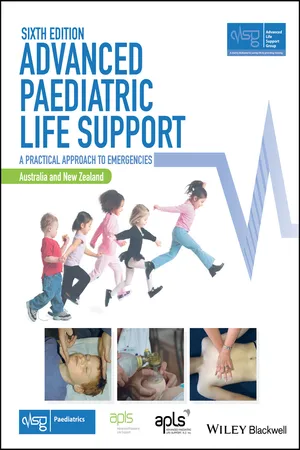
- English
- ePUB (mobile friendly)
- Available on iOS & Android
About this book
Advanced Paediatric Life Support is the internationally renowned manual on emergency paediatric care, written to support the course run by the Advanced Life Support Group. This edition has been adapted specifically for use in Australia and New Zealand, with the latest procedures, medications and clinical best practice to match the guidelines of the Australia and New Zealand Resuscitation Councils. Using their structured approach, a tried and tested practical method of treating children during the crucial first few hours of a life threatening illness or injury, Advanced Paediatric Life Support is used by doctors, nurses and allied health professionals dealing with emergencies in children. Its clear layout and straightforward style make it a highly practical tool both for training and in the event of an emergency.
The sixth edition includes major new features bringing it right up to date, including:
- Fully adapted for use in Australia and New Zealand, with updates to chapters on shock, the choking child, basic life support and cardiac arrest
- The latest International Liaison Committee on Resuscitation (ILCOR) 2015 Guidelines
- The latest consensus guidelines on paediatric trauma
- Enhanced discussions on the importance of human factors
- A new and improved design including full colour photographs and diagrams
- Free access to the Wiley E-Text
With this book at hand, all those providing care during paediatric emergencies can be confident in having comprehensive and authoritative guidance on the recognition and management of life threatening conditions necessary to save a child's life.
Frequently asked questions
- Essential is ideal for learners and professionals who enjoy exploring a wide range of subjects. Access the Essential Library with 800,000+ trusted titles and best-sellers across business, personal growth, and the humanities. Includes unlimited reading time and Standard Read Aloud voice.
- Complete: Perfect for advanced learners and researchers needing full, unrestricted access. Unlock 1.4M+ books across hundreds of subjects, including academic and specialized titles. The Complete Plan also includes advanced features like Premium Read Aloud and Research Assistant.
Please note we cannot support devices running on iOS 13 and Android 7 or earlier. Learn more about using the app.
Information
PART 1
Introduction
CHAPTER 1
Introduction
Learning outcomes
- Describe the focus of the APLS course
- Identify the important differences in children and their impact on the management of emergencies
1.1 Introduction
1.2 Principles
Physiological differences
| Age | Guide weight (kg) | RR At rest Breaths per minute 5th–95th centile | HR Beats per minute 5th–95th centile | BP Systolic | |||
| Boys | Girls | 5th centile | 50th centile | 95th centile | |||
| Birth | 3.5 | 3.5 | 25–50 | 120–170 | 65–75 | 80–90 | 105 |
| 1 month | 4.5 | 4.5 | |||||
| 3 months | 6.5 | 6 | 25–45 | 115–160 | |||
| 6 months | 8 | 7 | 20–40 | 110–160 | |||
| 12 months | 9.5 | 9 | 70–75 | 85–95 | |||
| 18 months | 11 | 10 | 20–35 | 100–155 | |||
| 2 years | 12 | 12 | 20–30 | 100–150 | 70–80 | 85–100 | 110 |
| 3 years | 14 | 14 | 90–140 | ||||
| 4 years | 16 | 16 | 80–135 | ||||
| 5 years | 18 | 18 | 80–90 | 90–110 | 111–120 | ||
| 6 years | 21 | 20 | 80–130 | ||||
| 7 years | 23 | 22 | |||||
| 8 years | 25 | 25 | 15–25 | 70–120 | |||
| 9 years | 28 | 28 | |||||
| 10 years | 31 | 32 | |||||
| 11 years | 35 | 35 | |||||
| 12 years | 43 | 43 | 12–24 | 65–115 | 90–105 | 100–120 | 125–140 |
| 14 years | 50 | 50 | 60–110 | ||||
| Adult | 70 | 70 | |||||
Relationship between disease progression and outcomes

Standardised structure for assessment and stabilisation
Table of contents
- Cover
- Title Page
- Table of Contents
- Clinical conditions list
- Working group
- Contributors
- Preface to the first edition
- Preface to the sixth edition
- Preface to the modified Australia and New Zealand sixth edition
- Acknowledgements
- Contact details and further information
- How to use your textbook
- PART 1: Introduction
- PART 2: The seriously ill child
- PART 3: The seriously injured child
- PART 4: Life support
- PART 5: Practical application of APLS
- PART 6: Appendices
- Index
- End User License Agreement